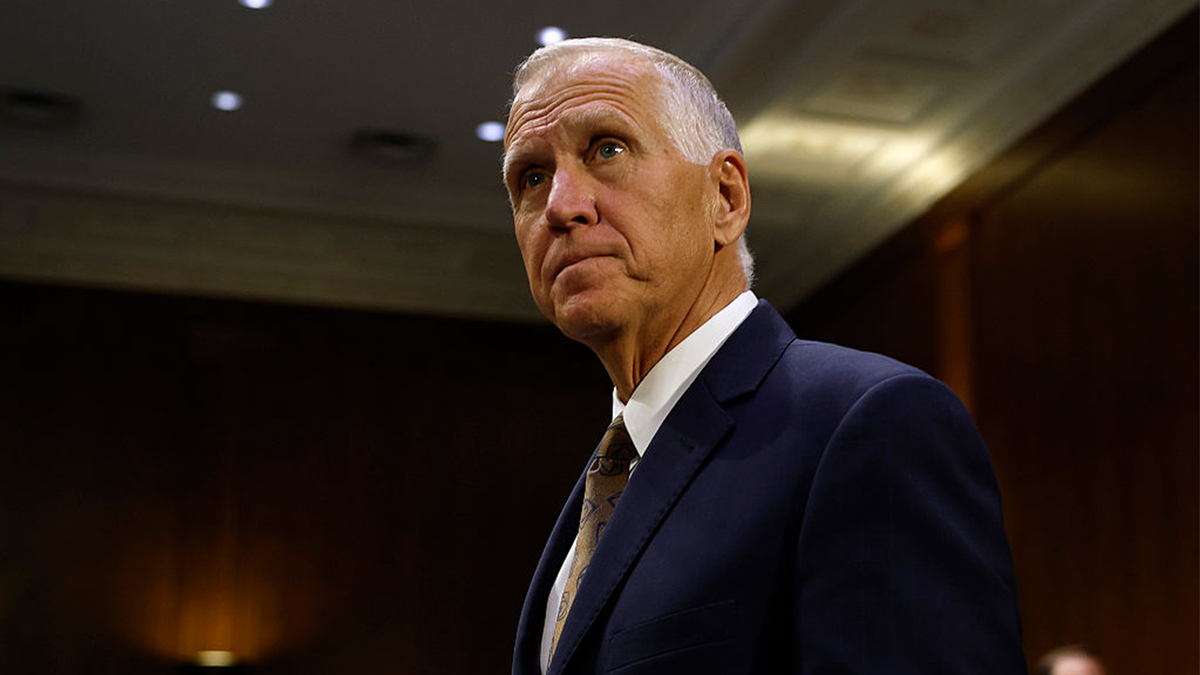INTERNACIONAL
DHS fires back at Democrats for ‘beyond the pale’ rhetoric as ICE agents face wave of violent threats

NEWYou can now listen to Fox News articles!
The Department of Homeland Security (DHS) is continuing to call on Democrats to tone down the rhetoric against Immigration and Customs Enforcement agents as riots not only persisted in Los Angeles Sunday night, but agents continue to face threats of doxxing and violence.
The department has taken issue with not only California leaders but also House Minority Leader Hakeem Jeffries, Boston Mayor Michelle Wu and Minnesota Gov. Tim Walz.
«The violent targeting of law enforcement in Los Angeles by lawless rioters is despicable and Mayor Bass and Governor Newsom must call for it to end,» DHS Assistant Secretary Tricia McLaughlin said in a Saturday statement. «The men and women of ICE put their lives on the line to protect and defend the lives of American citizens.»
ACTING ICE DIRECTOR CALLS MAYOR WU’S NEO-NAZI COMPARISON ‘DISGUSTING’ AMID INCREASE IN AGENT ASSAULTS
The Department of Homeland Security (DHS), led by Secretary of Homeland Security Kristi Noem, is continuing to call on Democrats to tone down the rhetoric against Immigration and Customs Enforcement agents. (Kevin Lamarque/Reuters)
«Make no mistake, Democrat politicians like Hakeem Jeffries, Mayor Wu of Boston, Tim Walz, and Mayor Bass of Los Angeles are contributing to the surge in assaults of our ICE officers through their repeated vilification and demonization of ICE,» McLaughlin stated. «From comparisons to the modern-day Nazi Gestapo to glorifying rioters, the violent rhetoric of these sanctuary politicians is beyond the pale. This violence against ICE must end.»
The department says there’s been a 413% increase in assaults against ICE agents, which comes as the riots in Los Angeles are centered against the presence of the agency in the city.
Wu and Jeffries recently faced criticism for their comments on ICE agents masking while conducting sweeps to conceal their identity for safety reasons.
«Every single ICE agent who is engaged in this aggressive overreach and are trying to hide their identities from the American people will be unsuccessful in doing that,» Jeffries said on Capitol Hill.
«This is America. This is not the Soviet Union,» he added, saying identification is needed to comply with the law and have proper «transparency.» «We’re not behind the Iron Curtain. This is not the 1930s. And every single one of them, no matter what it takes, no matter how long it takes, will of course be identified.»
Wu was slammed for comments where she drew a tie between ICE and neo-Nazi group Nationalist Social Club-131 for the masking decision, which DHS called «sickening,» according to the Boston Herald.
FEDERAL OFFICIALS SLAM DEMOCRATS FOR ‘DANGEROUS’ RHETORIC AS ICE AGENTS FACE VIOLENT MOBS IN LA, NYC

In response to an online video of a Democratic state representative in Tennessee allegedly stalking ICE agents, the DHS said that «this Administration is not playing games with the lives and safety of our ICE officers.» (Minh Connors/Anadolu via Getty Images and ICE)
«I don’t know of any police department that routinely wears masks,» Wu said. «We know that there are other groups that routinely wear masks. NSC-131 routinely wears masks.»
Minnesota Gov. Tim Walz, who was the Democratic vice presidential nominee in 2024, also controversially drew a comparison to the Nazis in May.
CLICK HERE FOR MORE IMMIGRATION COVERAGE
«I’m gonna start with the flashing red light — Donald Trump’s modern-day Gestapo is scooping folks up off the streets,» Walz claimed at a University of Minnesota law school commencement speech. «They’re in unmarked vans, wearing masks, being shipped off to foreign torture dungeons. No chance to mount a defense. Not even a chance to kiss a loved one goodbye. Just grabbed up by masked agents, shoved into those vans, and disappeared.»
In California, the anti-ICE riots triggered an order from President Donald Trump to deploy to the National Guard, which Newsom is expected to take legal action against. Newsom repeatedly has said that the Trump administration has instigated the situation «to manufacture chaos and violence,» and has said that those who are committing «violent acts» will face legal repercussions and are playing into the president’s hands.
ICE OFFICIAL PUTS POLITICIANS ON BLAST, DEMANDING THEY ‘STOP PUTTING MY PEOPLE IN DANGER’

National Guard are deployed around downtown Los Angeles, Jun. 8, 2025, following an immigration raid protest the night before. (Eric Thayer/The Associated Press)
«Continued chaotic federal sweeps, across California, to meet an arbitrary arrest quota are as reckless as they are cruel,» Newsom stated Friday. «Donald Trump’s chaos is eroding trust, tearing families apart, and undermining the workers and industries that power America’s economy.»
Los Angeles Mayor Karen Bass called on residents not to «engage in violence and chaos» and to not «give the administration what they want,» Sunday in an X post, but faced scrutiny for Friday comments saying that «these tactics sow terror in our communities and disrupt basic principles of safety in our city.»
CLICK HERE TO GET THE FOX NEWS APP
When Fox News Digital reached out to Newsom’s office about DHS’ comments, they sent a link to a post in which Acting ICE Director Todd Lyons credited Newsom for complying with ICE detainers for those already behind bars.
Fox News Digital reached out to the offices of Wu, Bass, Walz and Jeffries and did not receive replies.
INTERNACIONAL
Trump border wall materials sold by Biden may soon find their way back to the feds, auctioneer claims

NEWYou can now listen to Fox News articles!
FIRST ON FOX: The global government-surplus auction house that listed unused components of President Donald Trump’s border wall under the Biden administration told Fox News Digital on Friday that it plans to coordinate with the Trump administration to return some of the materials to the federal government.
In January 2021, President Joe Biden set in motion the chain of events that would eventually lead to the sale of unconstructed border wall components and implements.
«Like every nation, the United States has a right and a duty to secure its borders and protect its people against threats. But building a massive wall that spans the entire southern border is not a serious policy solution,» Biden said in an executive order halting construction.
Until Friday, the ultimate fate of the unused border wall materials – originally estimated to be worth between $260 million and $350 million – remained largely unclear. A contentious court battle in Texas last December resulted in a 30-day freeze on the auctions, but little has publicly transpired since.
BORDER WALL CONSTRUCTION SURGES AHEAD AS ILLEGAL CROSSINGS PLUMMET TO HISTORIC LOWS
Piles of unused border fence sit at one of the border wall construction staging areas on the Johnson Ranch near Columbus, New Mexico, on April 12, 2021. (Getty)
In a statement to Fox News Digital, GovPlanet – an auction clearinghouse for public-sector and government surplus – announced Friday they have reached a breakthrough deal with the Trump administration.
«GovPlanet has reached an agreement, working with the Office of the Border Czar, to return border wall materials that were previously deemed surplus and sourced by the federal government to GovPlanet via existing contracts,» said the company, a subsidiary of an Illinois-founded, British Columbia-based international operation called Ritchie Brothers Auctioneers-RB Global.
«A third-party firm that has been contracted for construction of the border wall will take receipt of the materials over the next 90 days,» GovPlanet added.
GovPlanet officials said they were pleased to work with the administration to return the materials «at-cost» to the feds and «protect the millions of dollars that U.S. taxpayers had already invested in this initiative.»
«We are expediting the transfer of these materials to support the administration’s border protection plans. We value our longstanding partnership with the U.S. government and look forward to continuing to support America’s federal agencies.»
TRUMP’S BORDER WALL EXPANSION MOVES FORWARD IN SEVERAL CRITICAL AREAS: ‘CRISIS IS NOT YET OVER’
Asked about the claim from the auction house, a White House official told Fox News Digital the Trump administration is «grateful for all third parties who are interested in helping keep America’s borders safe and secure.»
After Biden’s order freezing construction, which ultimately led to the erstwhile auctions, Sens. Deb Fischer, R-Neb., and Joni Ernst, R-Iowa, said taxpayer money was being spent by the Pentagon to guard the materials as they languished in the New Mexico desert.
A 2023 release from Fischer cited a $130,000-per-day figure for the storage and security of the panels in New Mexico and Arizona.
A provision in the annual 2024 National Defense Authorization Act (NDAA) required the Pentagon to submit a plan for transfer or sale of the materials.
About 60% of the border wall components were transferred to southwestern states like Texas and California as well as U.S. Customs and Border Protection.
Texas Lt. Gov. Dan Patrick told Fox News at the time that Texas purchased about $12 million from an auction.
Tens of thousands of bollards, panels and components, including structural tubing, were later put up for auction on GovPlanet.
Dozens of lots of materials were listed for auction by August 2023, according to the New York Post. The paper cited a $154,200 payday for 729 «hollow beams,» in one example.
Screenshots on ABC-15 Phoenix’s website showed 33-foot by 8-foot steel wall panels being sold for $1 apiece in sets of five.
Ernst lambasted the administration upon the news, saying that materials purchased with hard-earned taxpayer funds were being sold for «pennies on the dollar.»
By that time, a total of $498,000 had been paid for the overall materials, according to Newsweek. The outlet cited the U.S. Army Corps of Engineers in confirming the implements were being marketed in accordance with federal acquisition regulations.
REPUBLICAN AGS VISIT US-MEXICO BORDER WALL AS TRUMP’S ‘BIG, BEAUTIFUL BILL’ CLEARS EXPANSION FUNDING
But, the trail began to go cold after that hot summer, as Lt. Gov. Patrick informed Hearst Newspapers in December he had been told that any further sales would be frozen until after Trump’s second inauguration.
Texas Land Commissioner Dawn Buckingham argued in court that the Biden administration was ignoring prior court orders by selling off the components, according to the Houston Chronicle.
GovPlanet appeared to de-list the items around that time.
In a Dec. 27 ruling, Texas federal Judge Drew Tipton barred the selling of wall materials for 30 days, according to Law & Crime.
The outlet added, citing Texas Attorney General Ken Paxton, that Tipton further asked the Biden administration to explain whether it violated a prior ruling in Texas’ favor that required certain funds be spent on border wall construction.
Texas had claimed Biden’s auctions were netting buyers wall components at a rate that would have added up to about a half-mile per day, if constructed as Trump originally intended.
CLICK HERE TO GET THE FOX NEWS APP
There appeared to have been little movement on the sales since the 30-day moratorium expired in January, until Fox News Digital contacted GovPlanet on Friday.
Several reports said the federal government no longer owns the border wall components the Biden administration set for auction, and that GovPlanet/RBGlobal legally possesses them.
Art del Cueto, a Border Patrol union official, told ABC-15 that the stock cited in reports on the sales could «pretty much be utilized.»
«They could put down footing, pick it back up and use it,» he said.
«When you have to start with the new administration, wanting to rebuild it, what are we going to have to do, you’re going to have to use more taxpayer-funded money, which is insane to me,» del Cueto added.
Fox News Digital reached out to Patrick’s office and DHS for comment.
immigration,joe biden,california,texas,border security,illegal immigrants
INTERNACIONAL
El enemigo público número uno de Francia y Canadá cuyo nombre fue sinónimo de asesinatos, fugas y violencia

Jacques Mesrine
Era el 2 de noviembre de 1979 y la Porte de Clignancourt hervía de tráfico. El Renault Estafette policial, de color blanco, aguardaba detenido en la esquina, como si su conductor esperara una señal. Adentro, en silencio, un comando de la Brigade de Recherche et d’Intervention sostenía los fusiles con las culatas apoyadas en las rodillas. Faltaban segundos. Y en esos segundos se condensaban casi dos décadas de persecuciones, fugas, atracos, asesinatos y titulares que habían convertido a Jacques Mesrine en el enemigo público número uno de Francia y también de Canadá.
Mesrine robó y mató en dos continentes, se había fugado de cárceles consideradas inexpugnables, desafiado a jueces en sus propios despachos y burlado la vigilancia en pleno tribunal. Lo habían buscado en París, Montreal, Quebec, Caracas y en cada camino intermedio. Su nombre ya era sinónimo de fuga, audacia y violencia. Pero también era un espejo incómodo para un país que, al condenarlo, parecía al mismo tiempo fascinado por él. Aquella mañana de noviembre, mientras su BMW 528i gris se acercaba al cruce, Mesrine no lo sabía, pero la Francia que lo había convertido en leyenda estaba a punto de eliminarlo.
Jacques Mesrine nació el 28 de diciembre de 1936 en Clichy-la-Garenne, un suburbio industrial al noroeste de París. Su padre, Albert, trabajaba como empleado en una fábrica, hombre de carácter reservado; su madre, Fernande Boulogne, era costurera, más severa que cariñosa, preocupada por la respetabilidad de la familia. Jacques creció en una casa donde la autoridad era clara y la infancia tenía límites marcados por la austeridad de una clase media que aspiraba al orden más que a la aventura.
Leé también: Secuestró un avión, cobró un rescate récord y saltó en paracaídas: 54 años después, nadie sabe si sobrevivió
En 1956, con 19 años, ingresó en el ejército francés y fue enviado como paracaidista a Argelia en plena guerra colonial. Ese conflicto fue brutal… para los argelinos. Era una lucha de emboscadas, allanamientos, interrogatorios y represión. Mesrine, como otros jóvenes soldados, fue testigo y partícipe de ejecuciones sumarias y torturas. Argelia le enseñó a mirar la vida y la muerte con un desapego que no lo abandonaría jamás.
Regresó a Francia en 1959. El país, que vivía el clima político tenso de la Quinta República de De Gaulle, no recibía a los veteranos con honores. Sus empleos fueron inestables: vendedor, camarero, decorador de interiores. Se aburría. Caminó despacio hacia el bajo mundo, como quien no quiere la cosa. En los cafés de Pigalle y Montmartre, conoció a viejos camaradas de armas que también buscaban algo más rentable y divertido que la vida como empleados.
Conoció a ladrones, falsificadores y contrabandistas y comenzó con robos menores
Sus objetivos fueron coches de lujo y joyerías pequeñas. Jean-Lucien Raid, conocido ladrón de bancos, le dio una mano. Vio en él algunas condiciones que no eran comunes en el hampa, cierta ética si cabe la palabra: cumplía lo pactado, repartía el botín sin trampas, se ponía al frente cuando las cosas no salían bien, no explotaba mujeres, no traficaba droga. Jacques Mesrine.
La policía lo conoció como un ladrón de golpes rápidos, sin sangre en la mayoría de los casos, planificados y con ejecución impecable. Iniciaban los años 60 cuando lo detuvieron por primera vez. De la cárcel salió con más conocimientos y más contactos.
En esa época, la mafia corsa mandaba en París y Marsella. Controlaban el juego, la prostitución, los asaltos y una parte importante de la ruta de heroína que salía de Marsella rumbo a Norteamérica, la célebre “French Connection”. Los clanes corsos operaban con jerarquías rígidas y con un sentido de la “familia” que mezclaba lealtades, dinero y silencios comprados.
Mesrine, ladrón reconocido
Comenzó a frecuentar este nuevo ambiente. Sin embargo, no era un hombre que encajara: no aceptaba recibir órdenes. Podía colaborar, pero no someterse. No participó en ninguna operación de drogas (no era un moralista; creía que llamaba más la atención de la Policía que el robo de bancos). Y veía la explotación de mujeres como un negocio que generaba enemigos por todos lados. En fin, fue un colaborador ocasional de los corsos. No se integró. Era un lobo independiente.
Este desencuentro con los corsos, más que cerrarle puertas, lo empujó a mirar hacia afuera: Canadá, Venezuela y otros destinos donde podía moverse sin estar atado a nadie.
En 1965, Jacques había concluido su primer matrimonio con Lydia de Souza. Conoció entonces a Jeanne Schneider. Ella trabajaba en un club nocturno de Pigalle, donde alternaba con clientes. Él quedó atraído por su astucia y su capacidad de sostenerle la mirada sin vacilar. Tres años después la pareja decidió dejar Francia. La Policía lo tenía en la mira y podía terminar mal.
Canadá ofrecía un cambio de escenario: anonimato
En Montreal, Jeanne y Jacques se presentaron como un matrimonio en busca de trabajo y fueron contratados por el industrial Georges Deslauriers, un empresario de éxito, con una discapacidad física que lo mantenía en su mansión de Mont‑Saint‑Hilaire. Mesrine hizo de chofer y ocasional ayudante, Jeanne de ama de llaves. En esos roles, duraron unos meses. La ruptura llegó por un incidente menor: una discusión entre Mesrine y el jardinero de la propiedad escaló hasta el punto de tensar la relación con Deslauriers.

Mesrine armado.
Pocas semanas después, el 12 de enero de 1969, Mesrine y Schneider secuestraron a Deslauriers, trasladándolo a un lugar apartado y exigiendo un rescate de 200.000 dólares. El cautiverio no duró mucho: el empresario logró escapar. Eran mejores ladrones que secuestradores. La prensa de Montreal los apodó los “Bonnie y Clyde franceses”. Ellos cruzaron la frontera hacia los Estados Unidos. En el camino, se alojaron en un motel. La propietaria, Evelyne Lebouthillier, apareció muerta en circunstancias que la Policía vinculó con la pareja.
El 30 de junio de 1969, Mesrine y Schneider fueron arrestados en el estado de Arkansas gracias a los informes proporcionados por la Policía de Quebec. Los extraditaron a Canadá. En enero de 1971, fueron absueltos por falta de pruebas en el caso Lebouthillier, pero con el secuestro de Deslauriers no les fue tan bien: Jacques recibió 10 años de prisión y Jeanne 5. Ella fue enviada a una cárcel de Montreal y Mesrine a Saint‑Vincent‑de‑Paul, en Laval, Quebec. Jeanne fue liberada a mediados de los años 70. El resto de su vida transcurrió con discreción.
Jean‑Paul Mercier y una fuga histórica
Jean‑Paul Mercier era un asaltante de bancos canadiense que se relacionó en prisión con Mesrine. La conexión Mesrine‑Mercier sería determinante, y no solo para su estancia en prisión: estaba a punto de convertirse en una sociedad que daría forma a una de las fugas más comentadas de la historia criminal canadiense. Jean‑Paul conocía la prisión de memoria y sabía que las rutinas podían ser aprovechadas. Ambos fueron asignados a trabajos en la carpintería del penal. ¡Tenían a disposición materiales, herramientas y vigilancia muy relajada!
Leé también: Timothy McVeigh, el supremacista que se creyó patriota y mató a 168 personas con 1800 kilos de explosivos
Allí, mientras cortaban madera y reparaban mobiliario, comenzaron a planificar. Con ayuda de otros cuatro internos de confianza, empezaron a ocultar limas y cuchillas que podían transformarse en armas. El 21 de agosto de 1972, durante el cambio de guardia al mediodía, en un momento en que la vigilancia era mínima, Mesrine y Mercier, junto con sus cómplices, controlaron a varios custodios de la carpintería, los desarmaron y tomaron sus pistolas. Avanzaron hacia el patio. La sorpresa limitó la cantidad de disparos de guardias desprevenidos. Llegaron a la puerta principal. Los guardias externos fueron neutralizados, les sacaron las llaves y salieron. Los esperaba un automóvil.
Apenas diez días después, con los ojos de Canadá puestos sobre sus movimientos, Mesrine y Mercier regresaron a la misma prisión para rescatar a sus compañeros. Dispararon contra los muros y los puestos de vigilancia. Dos guardias resultaron heridos y Mercier recibió impactos en la pierna y el brazo. La operación fracasó para ellos y huyeron.
Tras la fuga del 21 de agosto de 1972 y el ataque fallido al penal del 3 de septiembre, Mesrine y Mercier siguieron juntos un tiempo, alternando escondites en zonas rurales de Quebec y golpes rápidos a bancos y comercios.
Los asesinatos de Mesrine
El Servicio de Policía de Montreal y la Sûreté du Québec se empeñaron en capturarlos. El 10 de septiembre de 1972, los prófugos fueron hasta una zona boscosa cerca de Saint‑Louis‑de‑Blandford, para practicar tiro al blanco. En un automóvil, llevaban armas. El ruido de las detonaciones alertó a guardabosques locales que se acercaron a investigar. Los guardabosques eran Médéric Côté, de 62 años, y Ernest Saint‑Pierre, de 50 años. Mesrine mató a tiros a Côté y Mercier le disparó y mató a Saint‑Pierre.
En diciembre de 1972, atraparon a Mercier en Montreal (moriría cumpliendo su condena). Mesrine continuó prófugo. En ese contexto, aparece Jocelyne Deraiche, una joven canadiense vinculada a círculos mafiosos. A mediados de 1973, cuando la presión era extrema, la pareja cruzó hacia Estados Unidos con documentos falsos y apoyo de contrabandistas. Luego entraron en Caracas, Venezuela, donde secuestraron y robaron bancos. Cuando tuvieron el dinero suficiente, regresaron a Francia.
París era para Mesrine terreno conocido
En lugar de instalarse con bajo perfil buscó cultivar su imagen pública de criminal con códigos, lo que reiteró en numerosas entrevistas. La publicación de su libro L’Instinct de Mort reforzó ese personaje.
Sylvia Jeanjacquot, de unos 20 años, trabajaba en clubes nocturnos. Mesrine la sedujo con promesas de una vida aventurera, aunque implicaba estar junto a un hombre que vivía rozando la muerte o la cárcel. Desde entonces, Sylvia pasó a ser su pareja inseparable. Mesrine y Sylvia Jeanjacquot, su última compañera.
La Brigade de Recherche et d’Intervention (BRI) era la unidad más temida por los delincuentes de París. Su jefe, el comisario Robert Broussard, era conocido en todos los cafés y antros de Pigalle. En septiembre de 1973, la BRI ubicó su escondite, un departamento alquilado con nombre falso en la avenida de la Salpêtrière. Rodearon el edificio y el propio Broussard golpeó la puerta. Mesrine pidió ver su credencial, provocándolo. Abrió. Tenía un cigarro en la boca y levantó una botella de champagne. Broussard dijo más tarde: “Fue una rendición teatral”. Sobre la mesa del living, además del champagne y unas copas, había una pistola 9 milímetros.
20 años de prisión
La causa por robos, portación de arma y agresión a policías, se demoró meses. La Cour d’assises de Paris, con la presidencia del juez Charles Petit, lo condenó a 20 años de prisión. Durante el juicio, mantuvo su actitud provocadora: en un momento, extrajo una llave y la arrojó hacia los periodistas diciendo que era la llave que un guardia corrupto usaba para abrir sus esposas, insinuando que el sistema judicial y penitenciario estaba podrido desde adentro.
Con la sentencia firme, fue trasladado al penal de La Santé, en el distrito 14 de París, la prisión más emblemática de Francia, conocida por su régimen estricto, sus celdas de aislamiento y su arquitectura concebida para impedir fugas. Mesrine entró allí con la etiqueta de preso peligroso y con la vigilancia puesta sobre cada uno de sus movimientos. Muy fanfarrón, Mesrine decía: “Ninguna prisión es inviolable, depende de quién esté adentro”. Esperó.
En 1978, compartía pabellón con François Besse, otro fugitivo legendario, especialista en fugas y robos. Los dos pasaron semanas estudiando las rutinas carcelarias. La clave estuvo en los parloirs, las salas de visita entre presos y abogados. Mesrine tenía entonces como abogado a Georges Kiejman, que desconocía el plan de fuga, pero que Jacques llamaba a cada rato para poder analizar accesos y tiempos de vigilancia. Con la complicidad de los corsos desde afuera y guardias sobornados, lograron introducir armas y cuerdas.
La nueva fuga
El 8 de mayo de 1978, Mesrine y Besse, mientras iban hacia el parloir, dominaron a un guardia, inmovilizaron a otro custodio, se vistieron con la ropa de ellos. Fueron hasta un sector de mantenimiento y subieron a los techos. Con cuerdas, descendieron por la fachada exterior, donde los esperaba un vehículo. Todo fue a plena luz del día y rápido.
Los dos prófugos nunca permanecieron más de dos noches en un mismo lugar, cambiaban coches robados o alquilados con documentación falsa y mantenían el contacto con una red de apoyo proveniente tanto de los corsos como de viejos cómplices.
Semanas después de la fuga, robaron el Crédit Lyonnais de la Rue de la Convention. Luego asaltaron el Casino de Deauville. En estos golpes, la prensa desempeñó un papel clave: los diarios publicaban titulares con su nombre y Mesrine alimentaba su imagen de bandido público número uno. Concedió entrevistas, en especial a Libération y Paris Match, en las que denunciaba un sistema carcelario brutal.
Un golpe riesgoso
El juez Charles Petit, de la Cour d’assises de Paris, que lo había condenado a 20 años de prisión, fue el siguiente blanco de Mesrine. Ahora, prófugo y con prensa, decidió vengarse. Quería secuestrarlo. No buscaba dinero sino un golpe simbólico contra la justicia francesa.
Leé también: La adolescente de 16 años que disparó a mansalva contra una escuela primaria porque no le gustaban los lunes
La operación comenzó a gestarse a fines de 1978. François Besse, su socio en fugas y robos, rechazó el plan: no veía ningún beneficio práctico y entendía que el riesgo era enorme. Mesrine entonces recurrió a dos hombres de confianza: Jean‑Luc Coupé y Christian Kopf, viejos conocidos que no tenían la pericia de Besse. Los tres realizaron seguimientos de la rutina del juez.
La noche elegida, Mesrine y sus cómplices esperaron cerca de la residencia de Petit. El juez no apareció: había modificado su agenda por precaución. Jacques decidió entonces entrar en la propiedad. Tomó a la familia del juez como rehén, aunque por breve tiempo. El plan ya estaba comprometido: el objetivo no estaba en el lugar y la Policía estaba atenta. Cuando se iban, se encontraron con patrullas policiales. Se tirotearon. Jean‑Luc Coupé y Christian Kopf fueron arrestados. Mesrine escapó. El intento de secuestro del juez fue un fracaso. Dijeron luego que la orden de atrapar a Mesrine como sea vino del presidente Valéry Giscard d´Estaing.
Las 15:15 del 2 de noviembre de 1979
Mesrine manejaba un BMW 528i y se detuvo detrás de un camión con plataforma cubierta de lona, esperando que el semáforo se pusiera en verde. Se había colocado el cinturón de seguridad. De golpe se levantó la lona del camión. Lo último que Mesrine vio fue a cuatro agentes abriendo fuego desde el camión. El auto acribillado de Mesrine.
De las aproximadamente treinta balas disparadas con tres carabinas Ruger y una metralleta Uzi, dieciocho dieron en el «Enemigo Público n.º 1». Utilizaron balas explosivas semiblindadas, que causan heridas irreparables en el cuerpo al fragmentarse al impactar. Un policía que llegó a pie remató con un tiro en la sien. Esto ocurrió en la Puerta de Clignancourt, en el distrito XVIII de París, no lejos de la Calle de Belliard, donde vivía Mesrine.
La mayoría de los policías que participaron en esta emboscada admitió posteriormente que tenían órdenes de matar a Mesrine. Solo el jefe de policía, Robert Broussard, a cargo de toda la operación, dio la versión oficial: «Recibió una advertencia, pero intentó tirar las granadas que tenía en el píso del coche y los hombres le dispararon; punto».
Los policías también dispararon contra la acompañante de Mesrine, Sylvia Jeanjacquot. Sylvia recibió siete balazos en la cabeza pero sobrevivió. Perdió un ojo y fue operada varias veces.
La Policía permitió fotografiar y filmar el cadáver de Jacques Mesrine en el asiento del automóvil. La leyenda había terminado.
criminales históricos, secuestros, asesinatos
INTERNACIONAL
Senate Republicans reveal dramatic dealmaking behind Trump’s $3.3T megabill passage

NEWYou can now listen to Fox News articles!
Senate Republicans left Washington this week to sell President Donald Trump’s «big, beautiful bill,» but the road to creating and passing the legislation began just over a year and a half ago.
Trump’s $3.3 trillion megabill, crammed with his legislative priorities on border security, defense and energy, was a product months in the making. And it was the marquee policy in the bill, which was to extend or make permanent many of the 2017 Tax Cuts and Jobs Act, that was the driving force behind Republicans’ desire to pass it.
But Senate Republicans have had little time to rest on their laurels and celebrate the bill’s passage, spending the month since Trump signed it advancing a $9 billion clawback package and trying to ram through Senate Democrats’ blockade of the president’s nominees.
SENATE PASSES TRUMP’S ‘BIG, BEAUTIFUL BILL’ AFTER MARATHON VOTE-A-RAMA
President Donald Trump boards Air Force One bound for Scotland on July 25, 2025, at Joint Base Andrews, Maryland. (Andrew Harnik/Getty Images)
The journey to pass the bill began well before Republicans had a trifecta in Washington in early 2024, when then-Senate Republican Conference Chair John Barrasso, R-Wyo., hosted a policy retreat with Senate Republicans to hash out what the GOP’s agenda could look like should the win out in November.
And months later, Trump visited with Senate Republicans to discuss the strategy they had been working on behind-the-scenes.
«With President Trump in the White House, we discussed how Republicans will get America back on track,» Barrasso said at the time. «That starts with helping families escape the pain of Democrat high prices, unleashing American energy, stopping Democrat tax increases, and securing the Southern Border. Republicans are united.»
The real, nitty-gritty work began in January where concepts were taken and fleshed out into legislation.
Senate Majority Leader John Thune, R-S.D., opted to leapfrog the House and move forward with the Senate’s own budget framework, which initially divided the «big, beautiful bill» into two chunks. That added pressure on Republicans in the lower chamber to coalesce behind a plan of their own.
For much of the earlier part of this year, however, the Senate was waiting on the House to fine-tune and pass their own version of the bill. Still, Thune and his leadership team, including Sen. Markwayne Mullin, R-Okla., worked to get a product from one side of the building to the other that the Senate GOP could work with.
TRUMP’S ‘BIG, BEAUTIFUL BILL’ FACES REPUBLICAN FAMILY FEUD AS SENATE REVEALS ITS FINAL TEXT

Reporters surround Senate Majority Leader John Thune as he moves between his office and the Senate Chamber at the U.S. Capitol on Aug. 1, 2025, in Washington. (Chip Somodevilla/Getty Images)
And when the bill made its way to the upper chamber in early June, the pressure was on to deliver a finished product to Trump by July 4, an artificial deadline used to help corral lawmakers into finishing work on the bill.
One of the major disagreements in the upper chamber before the bill ever hit the floor was over the nature of cuts to Medicaid, particularly aimed at the provider tax rate. The issue was eventually smoothed over through the creation of a $50 billion rural hospital fund, but lawmakers who sounded the alarm against it vowed to ensure that the changes to the provider would never take effect.
«I think it was a huge mistake,» Sen. Josh Hawley, R-Mo., said at the time. «I think this has been an unhappy episode here in Congress, this effort to cut Medicaid.»
«And I think, frankly, my party needs to do some soul-searching,» he continued. «If you want to be a working class party, you’ve got to get delivered for working class people. You cannot take away health care from working people.»
And when the bill did finally hit the floor for what would evolve into a multi-day affair of passing through procedural hurdles, Senate Minority Leader Chuck Schumer, D-N.Y., forcing the reading of the entire bill and a marathon vote-a-rama, Senate Republicans were still not entirely on board.
At first, a cohort of fiscal hawks led by Sen. Ron Johnson, R-Wis., and Sen. Rick Scott, R-Fla., appeared to not support the package — they wanted even deeper cuts to Medicaid by tweaking the percentage that the federal government pays for healthcare in states that opted into Obamacare, which they argued would have saved billions extra.
They were offered an amendment that eventually never came to the floor, but was enough for them to back down from tanking the bill. And their resistance began in the first of a handful of huddles inside Thune’s office outside the Senate floor.
TAX CUTS, WORK REQUIREMENTS AND ASYLUM FEES: HERE’S WHAT’S INSIDE THE SENATE’S VERSION OF TRUMP’S BILL

Republican Sen. Thom Tillis of North Carolina announced in June that he wouldn’t run for a third term in the Senate when he is up for re-election in 2026. (Getty Images)
Sen. Cynthia Lummis, R-Wyo., joined them for the closed-door conversations, and told Fox News Digital that while her vote was not contingent on getting the change added, she wanted to make the case for why it should be.
«It saved a lot of money,» she said. «It saved a lot of money, and so I was anxious to see us use the opportunity, since we were able to open up mandatory spending, use the opportunity to really save some money.»
And later on, in the wee hours of the night, Republicans were bouncing from Thune’s office to the Senate floor, hashing out deals as they went to get Sen. Lisa Murkowski, R-Alaska, to support the bill, knowing that Sens. Susan Collins, R-Maine, and Thom Tillis, R-N.C., could vote against it.
«Sometimes it’s got to be put on a clock, because at some point the argument has to come to an end,» Mullin told Fox News Digital. «And that’s why we had to do some of it on the floor. We had to, we had to force the hand.»
CLICK HERE TO GET THE FOX NEWS APP
And in the end, only three Republicans, Sens. Rand Paul of Kentucky, Collins and Tillis voted against the bill. From there it went to the House, where Republicans in the lower chamber had their own dramatic rally to pass the legislative behemoth.
And now, as Republicans scatter to their home states to sell the bill to their constituents, Tillis said that the «foundational» piece of information that lawmakers can share is that they averted a nationwide tax hike.
«The shame of the Medicaid provision is that the vast majority of the bill is supported,» he told Fox News Digital. «I think we have to remind them the problem with the tax bill is they’re not going to see a cut, but if we hadn’t done it, they would have seen a historic increase.»
«So we need to remind them of what we’re doing is continuing what we started, and the economy that we created, it was able to withstand COVID,» he continued. «And I firmly believe if we hadn’t passed it. We’d have been in a different posture.»
politics,senate,donald trump,republicans

 POLITICA3 días ago
POLITICA3 días agoLa foto de Javier Milei con los candidatos de La Libertad Avanza en Buenos Aires: “Kirchnerismo nunca más”

 POLITICA2 días ago
POLITICA2 días agoMilei grabará la cadena nacional con un mensaje sobre los vetos orientado a “amurallar el déficit cero y la política monetaria”

 POLITICA3 días ago
POLITICA3 días agoLilia Lemoine reaccionó a las declaraciones de Diana Mondino y dijo que “atentó” contra el Presidente: “Está armado”
























